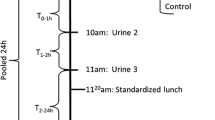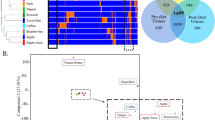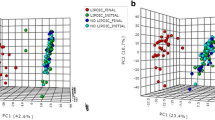Abstract
Cheese intake has been shown to decrease total cholesterol and LDL cholesterol concentrations when compared to butter of equal fat content. An untargeted metabolite profiling may reveal exposure markers of cheese but may also contribute with markers which can help explain how the intake of cheese affects cholesterol concentrations. Twenty-three subjects collected 2 × 24 h urine samples after 6 weeks of cheese and 6 weeks of butter intake with equal amounts of fat in a cross-over intervention study. The samples were analyzed by UPLC-QTOF/MS. A two-step univariate data analysis approach using linear mixed model was applied separately for positive and negative ionization mode: In the first step a total of 44 features related to treatment were identified and in the second step 36 of these features were related to total cholesterol concentrations. Cheese intake resulted in increased urinary indoxyl sulfate, xanthurenic acid, tyramine sulfate, 4-hydroxyphenylacetic acid, isovalerylglutamic acid and several acylglycines including isovalerylglycine, tiglylglycine and isobutyrylglycine when compared to butter intake of equal fat content. The biological mechanisms of action linking the metabolites to cholesterol concentrations need to be further explored.
Similar content being viewed by others
Abbreviations
- CVD:
-
Cardiovascular disease
- ESI:
-
Electrospray ionization
- LDL:
-
Low-density lipoprotein
- PABA:
-
Para-aminobenzoic acid
- RT:
-
Retention time
- UPLC-QTOF/MS:
-
Ultra-performance liquid chromatography quadrupole time-of-flight mass spectrometry
- XA:
-
Xanthurenic acid
References
Álvarez-Sánchez, B., Priego-Capote, F., & de Luque Castro, M. D. (2010). Metabolomics analysis I. Selection of biological samples and practical aspects preceding sample preparation. Trends in Analytical Chemistry, 29(2), 111–119.
Artaud-Wild, S. M., Connor, S. L., Sexton, G., & Connor, W. E. (1993). Differences in coronary mortality can be explained by differences in cholesterol and saturated fat intakes in 40 countries but not in France and Finland. A paradox. Circulation, 88, 2771–2779.
Badenhorst, C. P., van der Sluis, R., Erasmus, E., & van Dijk, A. A. (2013). Glycine conjugation: importance in metabolism, the role of glycine N-acyltransferase, and factors that influence interindividual variation. Expert Opinion on Drug Metabolism and Toxicology, 9(9), 1139–1153.
Barri, T., Holmer-Jensen, J., Hermansen, K., & Dragsted, L. O. (2012). Metabolic fingerprinting of high-fat plasma samples processed by centrifugation- and filtration-based protein precipitation delineates significant differences in metabolite information coverage. Analytica Chimica Acta, 718, 47–57.
Bennett, M. J., Powell, S., Swartling, D. J., & Gibson, K. M. (1994). Tiglylglycine excreted in urine in disorders of isoleucine metabolism and the respiratory chain measured by stable isotope dilution GC-MS. Clinical Chemistry, 40(10), 1879–1883.
Bijlsma, S., Bobeldijk, I., Verheij, E. R., et al. (2006). Large-scale human metabolomics studies: A strategy for data (pre-) processing and validation. Analytical Chemistry, 78(2), 567–574.
Bingham, S., & Cummings, J. H. (1983). The use of 4-aminobenzoic acid as a marker to validate the completeness of 24 h urine collections in man. Clinical Science (London), 64(6), 629–635.
Biong, A. S., Muller, H., Sejleflot, I., Veierod, M. B., & Pedersen, J. I. (2004). A comparison of the effects of cheese and butter on serum lipids, haemostatic variables and homocysteine. British Journal of Nutrition, 92, 791–797.
Brunet, P., Dou, L., Cerini, C., & Berland, Y. (2003). Protein-bound uremic retention solutes. Advances in Renal Replacement Therapy, 10(4), 310–320.
Commission of the European Communities. (1993). Reports of the Scientific Committee on Food: Nutrient and energy intakes for the European Community. Luxembourg: Office for Official Publications of the European Communities.
Curtin, A. C., & McSweeny, P. L. H. (2004). Catabolism of amino acids in cheese during ripening. In P. F. Fox, et al. (Eds.), Cheese: Chemistry, physics and microbiology (Third ed., Vol. 1, pp. 435–454). California: Elsevier Ltd.
Emadi, M., Jahanshiri, F., Kaveh, K., et al. (2011). Nutrition and immunity: The effects of the combination of arginine and tryptophan on growth performance, serum parameters and immune response in broiler chickens challenged with infectious bursal disease vaccine. Avian Pathology, 40(1), 63–72.
Fox, P. F., Guinee, T. P., Cogan, T. M., & McSweeny, P. L. (2000). Fundamentals of cheese science (1st ed.). Gaithersburg, Maryland: Aspen Publishers Inc.
Gartside, P. S., Wang, P., & Glueck, C. J. (1998). Prospective assessment of coronary heart disease risk factors: The NHANES I epidemiologic follow-up study (NHEFS) 16-year follow-up. Journal of the American College of Nutrition, 17(3), 263–269.
Gkouma, M., Cornu, A., Massouras, T., Lemaire, M., & Graulet, B. (2011). Comparative analysis of milk and cheese produced in the Pélardon PDO production zone based on their phenolic profiles. In M. Coppa (Ed.), Proceedings of the 10th international meeting on mountain cheese. Italy: University of Turin.
Gummalla, S., & Broadbent, J. R. (2001). Tyrosine and phenylalanine catabolism by Lactobacillus cheese flavor adjuncts. Journal of Dairy Science, 84(5), 1011–1019.
Hiratsuka, C., Fukuwatari, T., Sano, M., et al. (2013). Supplementing healthy women with up to 5.0 g/d of l-tryptophan has no adverse effects. Journal of Nutrition, 143(6), 859–866.
Hjerpsted, J., Leedo, E., & Tholstrup, T. (2011). Cheese intake in high amounts lowers LDL-cholesterol concentrations compared with butter intake of equal fat content. American Journal of Clinical Nutrition, 94, 1479–1484.
Huth, P. J., & Park, K. M. (2012). Influence of dairy product and milk fat consumption on cardiovascular disease risk: A review of the evidence. Advances in Nutrition, 3(3), 266–285.
Jakobsen, J., Pedersen, A. N., & Ovesen, L. (2003). Para-aminobenzoic acid (PABA) used as a marker for completeness of 24 hour urine: Effects of age and dosage scheduling. European Journal of Clinical Nutrition, 57(1), 138–142.
Keys, A., Anderson, J. T., & Grande, F. (1957). Prediction of serum-cholesterol responses of man to changes in fats in the diet. Lancet, 2(NOV16), 959–966.
Komprda, T., Burdychova, R., Dohnal, V., et al. (2008). Tyramine production in Dutch-type semi-hard cheese from two different producers. Food Microbiology, 25(2), 219–227.
Larsson, S. C., Virtamo, J., & Wolk, A. (2012). Dairy consumption and risk of stroke in Swedish women and men. Stroke, 43(7), 1775–1780.
Lichtenstein, A. H., Appel, L. J., Brands, M., et al. (2006). Diet and lifestyle recommendations revision 2006: A scientific statement from the American Heart Association Nutrition Committee. Circulation, 114(1), 82–96.
Linares, D. M., Del, R. B., Ladero, V., et al. (2012). Factors influencing biogenic amines accumulation in dairy products. Frontiers in Microbiology, 3, 180.
Mattson, F. H., & Grundy, S. M. (1985). Comparison of effects of dietary saturated, mono-unsaturated, and poly-unsaturated fatty-acids on plasma-lipids and lipoproteins in man. Journal of Lipid Research, 26(2), 194–202.
Mensink, R. P., & Katan, M. B. (1992). Effect of dietary fatty acids on serum lipids and lipoproteins. A meta-analysis of 27 trials. Arteriosclerosis and Thrombosis, 12, 911–919.
Mensink, R. P., Zock, P. L., Kester, A. D., & Katan, M. B. (2003). Effects of dietary fatty acids and carbohydrates on the ratio of serum total to HDL cholesterol and on serum lipids and apolipoproteins: A meta-analysis of 60 controlled trials. American Journal of Clinical Nutrition, 77(5), 1146–1155.
Moss, M., & Freed, D. (2003). The cow and the coronary: Epidemiology, biochemistry and immunology. International Journal of Cardiology, 87, 203–216.
Nagaoka, S., Masaki, H., Aoyama, Y., & Yoshida, A. (1986). Effects of excess dietary tyrosine or certain xenobiotics on the cholesterogenesis in rats. Journal of Nutrition, 116(5), 726–732.
Pluskal, T., Castillo, S., Villar-Briones, A., & Oresic, M. (2010). MZmine 2: Modular framework for processing, visualizing, and analyzing mass spectrometry-based molecular profile data. BMC Bioinformatics, 11, 395.
Primrose, S., Draper, J., Elsom, R., et al. (2011). Metabolomics and human nutrition. British Journal of Nutrition, 105(8), 1277–1283.
Rago, D., Kristensen, M., Gürdeniz, G., et al. (2013). A LC-MS metabolomics approach to investigate the effect of raw apple intake in the rat plasma metabolome. Metabolomics, 9, 1202–1215.
Raja, P. K., & Jarowski, C. I. (1975). Utility of fasting essential amino acid plasma levels in formulation of nutritionally adequate diets IV: Lowering of human plasma cholesterol and triglyceride levels by lysine and tryptophan supplementation. Journal of Pharmaceutical Sciences, 64(4), 691–692.
Saxholt, E., Christensen, A. T., Møller, A., Hartkopp, H. B., Hess Ygil, K. and Hels, O. H. Danish Food Composition Databank, revision 7. [version 7]. 2008. Department of Nutrition, National Food Institute, Technical University of Denmark. July 12, 2013.
Seely, S. (1988). Diet and coronary arterial disease: A statistical study. International Journal of Cardiology, 20, 183–192.
Sonestedt, E., Wirfalt, E., Wallstrom, P., et al. (2011). Dairy products and its association with incidence of cardiovascular disease: The Malmo diet and cancer cohort. European Journal of Epidemiology, 26(8), 609–618.
Steinberg, J. L., Orsulak, P. J., Raese, J. D., et al. (1993). Effects of tricyclic antidepressant treatment on tyramine-O-sulfate excretion in depressed patients. Journal of Affective Disorders, 27(1), 29–34.
Sumner, L. W., Amberg, A., Barrett, D., et al. (2007). Proposed minimum reporting standards for chemical analysis. Metabolomics, 3(3), 211–221.
Tholstrup, T., Hoy, C. E., Andersen, L. N., Christensen, R. D. K., & Sandstrom, B. (2004). Does fat in milk, butter and cheese affect blood lipids and cholesterol differently? Journal of the American College of Nutrition, 23(2), 169–176.
Torres-Leal, F. L., Fonseca-Alaniz, M. H., Teodoro, G. F., et al. (2011). Leucine supplementation improves adiponectin and total cholesterol concentrations despite the lack of changes in adiposity or glucose homeostasis in rats previously exposed to a high-fat diet. Nutrition and Metabolism (London), 8(1), 62.
van Aerde, M. A., Soedamah-Muthu, S. S., Geleijnse, J. M., et al. (2013). Dairy intake in relation to cardiovascular disease mortality and all-cause mortality: The Hoorn Study. European Journal of Nutrition, 52(2), 609–616.
von Ruesten, A., Feller, S., Bergmann, M. M., & Boeing, H. (2013). Diet and risk of chronic diseases: Results from the first 8 years of follow-up in the EPIC-Potsdam study. European Journal of Clinical Nutrition, 67(4), 412–419.
Wishart, D.S., Jewison, T., Guo, A.C. et al. (2013). HMDB 3.0–The human metabolome database in 2013. Nucleic acids research, 41, (Database issue) D801-D807 Accessed July 9, 2013.
World Health Organization. (1985). Energy and protein requirements. WHO, Geneva: Report of a joint FAO/WHO/UNU expert consultation.
Yvon, N., & Rijnen, L. (2001). Cheese flavour formation by amino acid catabolism. International Dairy Journal, 11, 185–201.
Zhang, Y., Guo, K., LeBlanc, R. E., et al. (2007). Increasing dietary leucine intake reduces diet-induced obesity and improves glucose and cholesterol metabolism in mice via multimechanisms. Diabetes, 56(6), 1647–1654.
Zhang, A., Sun, H., Wang, P., Han, Y., & Wang, X. (2012). Modern analytical techniques in metabolomics analysis. Analyst, 137(2), 293–300.
Acknowledgments
We would like to thank Sarah Schultz John for preparing the samples for analysis, Ümmühan Celik for preprocessing of data in MZmine, Maj-Britt Scmidt Andersen and Daniella Rago for laboratory assistance and Göezde Gürdeniz and Jan Stanstrup for sharing scripts in MATLAB. The research was supported by the Danish Dairy Research Foundation, DK-8260 Viby J, Denmark and the Dairy Research Institute, Rosemont, IL, USA.
Conflicts of interest
Julie Bousgaard Hjerpsted, Christian Ritz, Simon Stubbe Schou, Tine Tholstrup, Lars Ove Dragsted declared that they have no conflict of interest.
Ethical standards
All procedures followed were in accordance with the ethical standards of the responsible committee on human experimentation and with the Helsinki Declaration of 1975, as revised in 2000. Informed consent was obtained from all participants being included in the study.
Author information
Authors and Affiliations
Corresponding author
Electronic supplementary material
Below is the link to the electronic supplementary material.
Rights and permissions
About this article
Cite this article
Hjerpsted, J.B., Ritz, C., Schou, S.S. et al. Effect of cheese and butter intake on metabolites in urine using an untargeted metabolomics approach. Metabolomics 10, 1176–1185 (2014). https://doi.org/10.1007/s11306-014-0657-7
Received:
Accepted:
Published:
Issue Date:
DOI: https://doi.org/10.1007/s11306-014-0657-7




